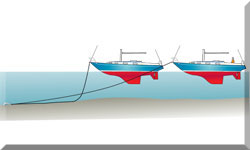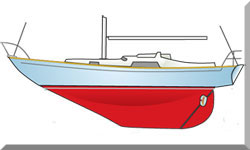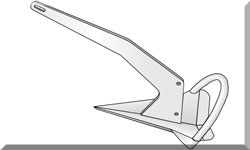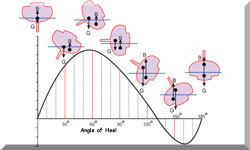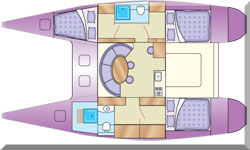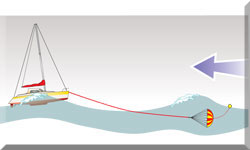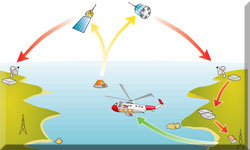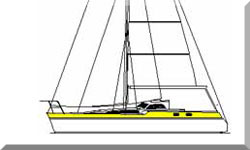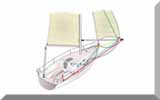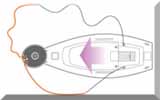- Home
- Electronics & Instrumentation
- SSB Marine Radio
- Small Boat Radar Systems: Your Questions Answered.
Small Boat Radar Systems: Your Questions Answered
Small Boat Radar Systems are invaluable for navigation in poor visibility conditions such as fog, rain, or nighttime. They enhance situational awareness by detecting nearby vessels, landmasses, and obstacles, reducing the risk of collisions. For small boat skippers, radar can be a lifesaver when navigating busy waterways or unfamiliar areas.
 Radar range is ultimately limited by the curvature of the earth
Radar range is ultimately limited by the curvature of the earthWhat are the limitations of radar systems?
What are the limitations of radar systems?
Radar performance can be affected by interference, sea clutter, and weather conditions like heavy rain. It also requires a clear line of sight, so obstacles like masts or landmasses can create blind spots. Regular maintenance and proper setup are essential to minimize these limitations.
Why don't small cruising boats commonly have radar systems?
Why don't small cruising boats commonly have radar systems?
Radar systems can be expensive to purchase and install, and they require a significant amount of power, which can be a concern for small boats with limited energy resources. Additionally, for daytime or fair-weather sailing, many skippers rely on visual navigation and other tools like AIS, making radar less of a priority.
Where is the best place to mount a radar system on a small boat?
Where is the best place to mount a radar system on a small boat?
For a sailboat, the mast is a common choice for mounting radar, as it provides a high vantage point for better range and coverage. However, this can affect the boat's balance and increase the risk of interference with sails. Stern poles or dedicated arches are alternatives that avoid these issues but may have slightly reduced range due to their lower height.
For a motorboat, it's often the top of the wheelhouse.
What are the disadvantages of radar systems on small boats?
What are the disadvantages of radar systems on small boats?
Besides the cost and power consumption, radar systems can be challenging to install and require a learning curve to interpret the data accurately. They also add weight to the boat, which can impact performance.
How can radar enhance safety during night sailing or in foggy conditions?
How can radar enhance safety during night sailing or in foggy conditions?
Radar helps detect hazards such as other vessels, landmasses, and floating debris, even in low visibility. This capability is invaluable for avoiding collisions and navigating safely in challenging conditions.
What is the range and coverage of modern radar systems?
What is the range and coverage of modern radar systems?
Many modern radar systems offer a range of up to 24 nautical miles or more, depending on the model and environmental conditions. The range can be adjusted to focus on nearby or distant targets as needed.
Can radar systems detect weather patterns?
Can radar systems detect weather patterns?
Advanced radar systems with Doppler technology can identify weather patterns, such as rain squalls or storms, allowing skippers to make informed decisions about their route and safety.
What are the best radar systems for small boats?
What are the best radar systems for small boats?
Popular brands like Furuno, Garmin, and Raymarine offer radar systems tailored for small boats. Features to consider include compact size, low power consumption, ease of integration with existing electronics, and advanced functionalities like Doppler radar for tracking moving targets.
What is the difference between radar and AIS (Automatic Identification System)?
What is the difference between radar and AIS (Automatic Identification System)?
Radar detects objects by bouncing radio waves off them, while AIS relies on transceivers to broadcast and receive vessel information like position, speed, and course. Radar can detect non-AIS targets like small boats or debris, making it more versatile. However, AIS provides detailed information about equipped vessels, which radar cannot.
Can radar detect small or non-AIS targets?
Can radar detect small or non-AIS targets?
Yes, radar can detect small targets like fishing boats, floating debris, or even wildlife. However, detection depends on factors like target size, material, and sea conditions. Using radar reflectors can improve the visibility of small boats on radar systems.
How do radar systems perform in different weather conditions?
How do radar systems perform in different weather conditions?
Radar systems are generally reliable in adverse weather, but performance can vary. Heavy rain may attenuate signals, reducing range and clarity. Fog and snow can also affect radar visibility. Modern radars often include features like Rain Mode to mitigate these effects.
How do I install and calibrate a radar system on my sailboat?
How do I install and calibrate a radar system on my sailboat?
Installation involves mounting the radar dome on a stable platform, ensuring it is free from obstructions. Calibration includes aligning the radar's heading and adjusting settings like gain, sea clutter, and rain clutter. It's best to follow the manufacturer's guidelines or consult a professional.
What are the costs involved in purchasing and installing radar?
What are the costs involved in purchasing and installing radar?
Costs vary widely, from a few hundred to several thousand dollars, depending on the system's features. Installation costs include mounting hardware, wiring, and integration with other electronics. While radar is a significant investment, its safety benefits often outweigh the expense.
Can radar systems integrate with other navigation tools?
Can radar systems integrate with other navigation tools?
Yes, modern radar systems can integrate with GPS, AIS, and chart plotters. This integration allows radar data to overlay on digital charts, enhancing situational awareness and navigation.
How much power does a radar system consume?
How much power does a radar system consume?
Power consumption varies by model, but modern radar systems are designed to be energy-efficient. For example, solid-state radars consume less power than traditional magnetron-based systems. This is crucial for sailboats relying on batteries and renewable energy sources like solar panels.
How do I interpret radar readings effectively?
How do I interpret radar readings effectively?
Interpreting radar displays requires practice. Key skills include identifying targets, understanding relative motion, and adjusting settings like gain and sea clutter. Many systems offer training modes or simulators to help users become proficient. Advanced features like chart overlays and target tracking simplify interpretation.
What are the maintenance requirements for radar systems?
What are the maintenance requirements for radar systems?
Regular maintenance includes cleaning the radar dome, checking for physical damage, and updating software. Periodic inspections ensure optimal performance and longevity.
What are the legal and safety considerations for using radar systems?
What are the legal and safety considerations for using radar systems?
Legal considerations include adhering to frequency regulations and power output limits. Safety involves proper installation to avoid radiation exposure and ensuring the radar does not interfere with other equipment.
Recent Articles
-
Is An SSB Marine Radio Installation Worth Having on Your Sailboat?
Apr 14, 25 02:31 PM
SSB marine radio is expensive to buy and install, but remains the bluewater sailors' favourite means of long-range communication, and here's why -
Correct VHF Radio Procedure: Your Questions Answered
Apr 14, 25 08:37 AM
Got a question about correct VHF radio procedure? Odds are you'll find your answer here... -
VHF Marine Radio; Which One is Right for Your Boat?
Apr 14, 25 05:09 AM
If you're looking to buy a VHF Marine Radio the choice can be a bit overwhelming. So what should it be, a fixed VHF or a handheld VHF? Maybe one with AIS or GPS built in perhaps?

